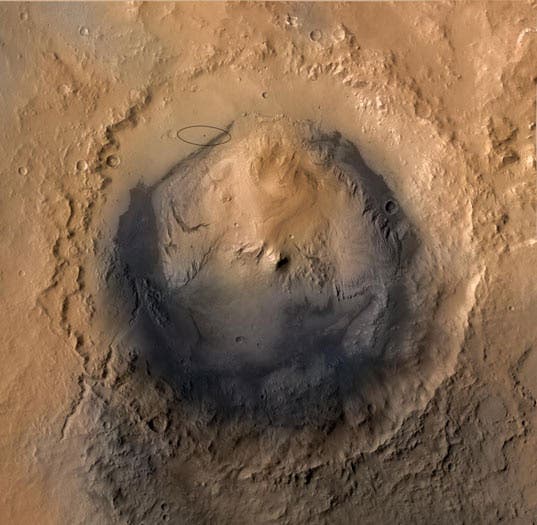The most sophisticated rover developed by NASA to date, the Mars Curiosity rover, is set to land on the red planet in August. During its one year mission, the rover’s main objective is that of investigating for signs that might hint towards the presence of life, past or present, on Mars. Scientists have unanimously agreed that the best place fur such an investigation is the 3 billion year old Gale Crater.
The time needed by the rover to reach the crater is directly dependent on the landing site, which is the most tricky and important part of the mission at the moment. The Mars Science Laboratory mission is worth $2.5 billion, which would make it extremely unfortunate were it to hit ridge or rock formation. To make sure the rover will land safely on Martian soil, scientists have developed highly complex computer models which take into account a wide arrange of factors.
For the first two rover missions on Mars, Spirit and Opportunity, scientists had a poorer understanding of the dynamics of Mars’ atmosphere compared to what the subsequent decade of Mars exploration has given us. Despite this the landings were sound successes. For the Mars Curiosity rover, its landing ellipse is a lot shorter than its predecessors. When mapping all the possible landing spots for the rover derived from the computer models, you end up with a scatter plot – drawing an oval around these points gives you the landing site ellipse.
During the first batch of simulations, the landing ellipse used to be 25 kilometers long by 20 kilometers wide, but now after a refined computations, it’s been shortened to 20 by 7, considerably shortening its expected arrival time at the Gale Crater. Curiosity’s handlers estimate that that will reduce the rover’s traverse time from landing site to mountain base by about four months – if you consider that its nominal mission time is of only one year, this makes for fantastic news!
“The most important thing perhaps is that we are steering to a different place in Gale Crater, which is a giant mountain of sedimentary rock,” said Curiosity contributor James Wray, an assistant professor of Earth and Atmospheric Science at the Georgia Institute of Technology. Unlike Curiosity’s predecessors, Opportunity and Spirit, “We are going with the intention of having to drive a long distance before even getting to what we want to study because the mountain is too steep,” Wray said.
Looking for signs of life by reading a 3 billion year old geological time machine
At the 3 billion year old Gale Crater, which was formed after it was struck by a meteorite, the rover will peer through the crater’s three milers of sediment – the perfect location for an investigation looking for signs of life. Wray said examining Gale Crater will be similar to going through Earth’s history by examining the layers of the Grand Canyon and learning, by the thickness and make up of the rocks, if they were once carved by oceans, lakes or air – basically it will look for signs of water, the main prerequisite for life.
“Basically, you could not have formed at least some of these minerals in some of these stacks of sediments without water,” he said.
Also, before it reaches the Crater, the rover will also collect samples on the run, which will provide scientists with even more details concerning Mars’ geology than prior, thanks to its more advanced instruments than those found on previous rover missions. This will also help NASA scientists gain a better understanding of how future astronauts would fare on Martian terrain. Other factors, important for manned missions, which the Mars Curiosity rover will study in greater detail than before will be radiation levels, organic matter on the Martian surface available, as well methane, which on Earth is produced in a proportion of 98% by living, biological entities.
via planetary.org










